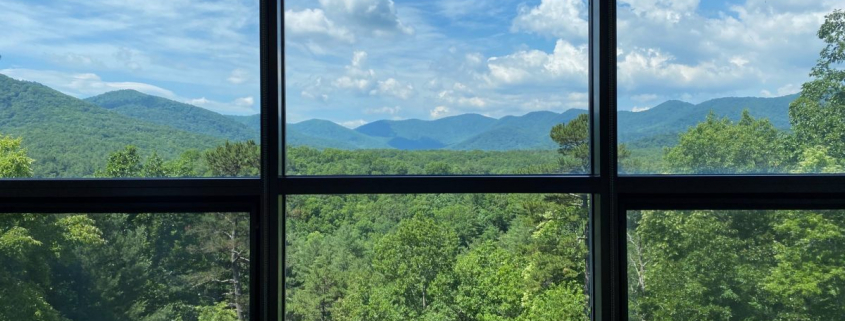NC Arboretum: People, Plants, Place, and Passion
Thursday June 23, 2022, Judy and I celebrated our 50th wedding anniversary at the North Carolina Arboretum, where I served on the Board 2001-2004, in my capacity as NC State University Vice Chancellor for Extension, Engagement, and Economic Development. Our dear friend, founding (1987) and still current Executive Director George Briggs, hosted us. This Post explores what I fondly refer to as Eden in the Southern Appalachians, with its mission driven by interconnecting People, Plants, Place, and Passion.
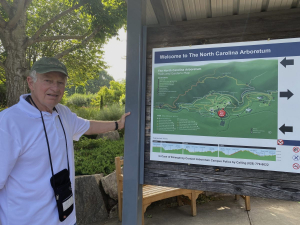
We arrived a few minutes early for our 10:00 AM rendezvous with George at the Education Center and its upstairs administrative offices.
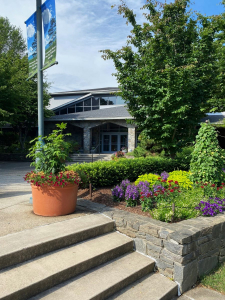
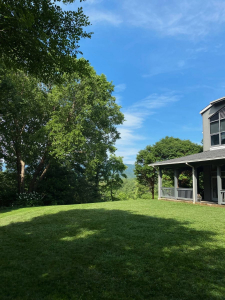
We enjoyed this 18-year-absence homecoming. I fell in love with the Arboretum when my NC State duties occasionally led me 250 miles west from our Cary, NC residence near Raleigh and the NCSU campus…from the Piedmont/coastal plain fall-line to the heart of the southern Appalachians. The air never failed to feel cooler, fresher, and ripe with promise.
John Muir loved the mountains:
- The mountains are calling and I must go.
- Few places in this world are more dangerous than home. Fear not, therefore, to try the mountain passes. They will kill care, save you from deadly apathy, set you free, and call forth every faculty into vigorous, enthusiastic action.
My NC State office looked out over some shrubbery and a parking lot. George’s office vista looks south deep into the Bent Creek Experimental Forest, Pisgah National Forest. Once again, John Muir:
- One day’s exposure to mountains is better than a cartload of books.
I could have gazed into the Bent Creek watershed for days…for ever.
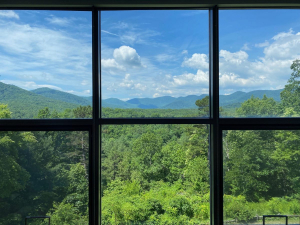
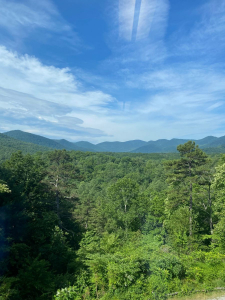
The Arboretum honors the legacy, the philosophy, and the spirit of Frederick Law Olmsted, the father of American landscape architecture. George and I posed beside one of the many images (each with an interpretive sign) of the designer of Central Park and the Biltmore grounds, among many others: The sign below contains an Olmsted quote that resonates with this old forester: If a man is not to live by bread alone, what is better worth doing well than the planting of trees.
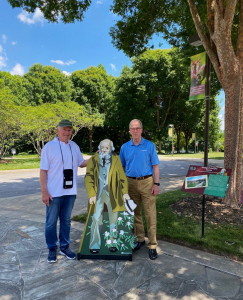
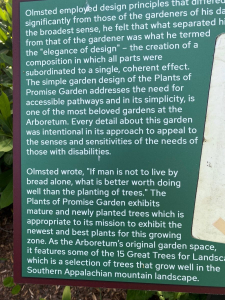
This sculpture depicts Olmsted holding a mapped garden design. The plaque reads: I must yet for a time keep the plan before me as a sculptor keeps his work under damp cloths, in a plastic form. Olmsted sought what he termed the elegance of design, the creation of a composition in which all parts are subordinated to a single, coherent effect, achieved perfectly in the composition below left.
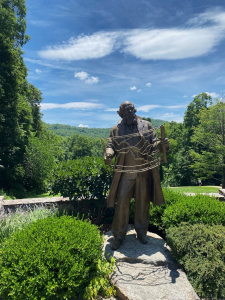
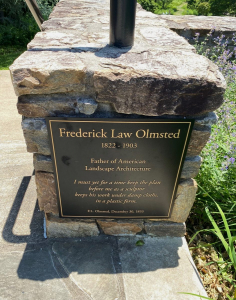
Olmsted left the lasting mark of his genius across the US, perhaps no more elegantly than here in these magnificent southern Appalachian mountains. I asked George whether the man actually visited, walked over any of the 434 acres of the original Biltmore property that became the Arboretum. We can’t be certain, yet George and I both felt his presence and his essence. What is clear and evident is that early in his work with George Vanderbilt, Olmsted offered this guidance for the Estate’s entire 125,000+ acres:
My advice would be to make a small park into which to look from your house; make a small pleasure ground and gardens; farm your river bottoms chiefly to keep and fatten livestock with a view to manure; and make the rest a forest, improving the existing roads and planting the old fields.
An acre covers 43,560 square feet, roughly equivalent to to a modern day football field between the sidelines and goal lines. One hundred twenty five thousand acres would extend a mile wide for 195 miles, the approximate distance from Huntsville to Montgomery, Alabama. The current Arboretum accounts for 3.472 one thousandths of the original estate. Did Olmsted set foot on this current-day Eden in the Southern Appalachians? Let’s not worry about the odds or the likelihood. Instead, if he views the progression of Biltmore and the original Estate grounds from his now otherworldly domain, let’s assume that he is quite familiar with the Arboretum!
People, Plants, Place, and Passion
I detect echoes of Olmsted in George, who holds dear to operating at the intimate intersection of people, plants, place, and passion…a congruence that defines the past, present, and future of this special place. The formal Mission: Cultivate connections between people and plants through creative expressions of landscape stewardship, including education, research, conservation, economic development and garden demonstration.
People
More than one-half million people visit the Arboretum annually. A group of K-5 students and teachers enjoyed a picnic lunch as we strolled the grounds on a mid-summer Thursday. I am sure bustling crowds visit the Arboretum during summer weekends.
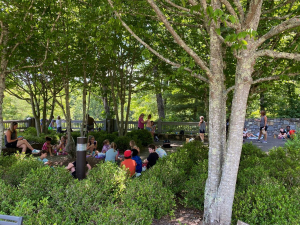
Plants
I’ve been a plant person my entire life, beginning as a toddler under the tutelage of my maternal grandmother, continuing through my forestry undergraduate degree, then through five decades of career practice and study, and then a final return to my immersive plant/Nature hobby in retirement.
Tree bark fascinates me, whether in the riparian forests of northern Alabama’s Wheeler National Wildlife Refuge or this eye-catching lacebark elm, so beautifully and aptly named.
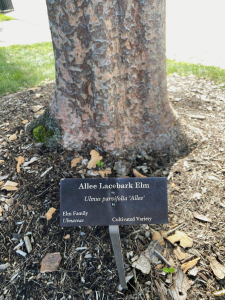
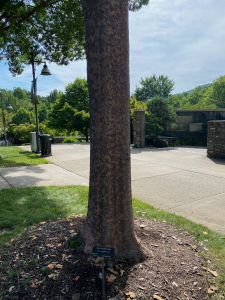
During my term at Auburn University as Alabama Cooperative Extension System Director (1996-2001), Judy and I grew quite fond of oakleaf hydrangea’s flowers, foliage, and exfoliating bark, a treat for all seasons. I’ve never seen it more abundant than on the Sipsey Wilderness in Alabama’s Bankhead National Forest. What a joy to see the species flourishing at the Arboretum and the nearby southern Appalachian forests.
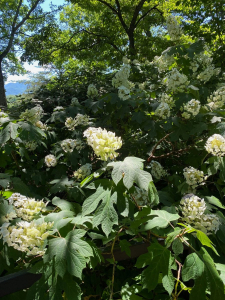
During my nine years on the forestry faculty at Penn State (1987-96), I worked closely with dear friend and colleague, Dr. Jim Finley, who passed away far to soon last October. We spent countless hours in Pennsylvania’s hardwood forests, whether deer or ruffed grouse hunting, conducting forest landowner workshops, or simply botanizing. Because I had practiced forestry in southern states 1973-85, I knew the sourwood tree well. Because sourwood’s principal range does not fall within Pennsylvania, it became a running inside joke that whenever I did not recognize a Pennsylvania tree we encountered, I would tell Jim that it may be a sourwood. I miss Jim, probably the most accomplished general forester I have known. The full-flower sourwood below center, visible outside George’s office window, brought back fond memories of shared woods ramblings and lessons learned.
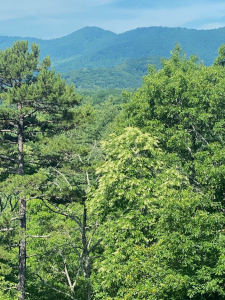
People and plants — a marriage essential to society and humanity. Consider our human dependence on plants for food, oxygen, building materials, and soul-nourishment. I don’t view the relationship as interdependent. Plants existed and flourished long before Homo sapiens made an appearance. Plants will extend indefinitely with or without us.
Place
My third book, Weaned Seals and Snowy Summits, co-authored with Dr. Jennifer Wilhoit, carries a relevant subtitle: Stories of Passion for Place and Everyday Nature! Place fuels my psyche and stirs my heart.
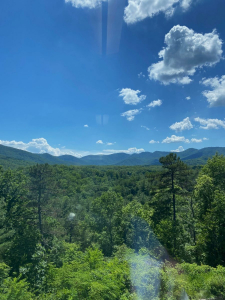
I’ve observed previously in these Posts that when driving to my birthplace in the central Appalachians, I feel a deep soul-stirring…a persistent peace and familiarity…when we range within 30 miles of Cumberland, Maryland. In fact, I sense strong comfort anywhere in the Appalachians. The view from George’s office, I admit, when combined with the sentiment of great memories, triggered a brief case of misty eyes.
Don’t get me wrong, it is not just mountains that draw me to place, yet wrinkled land surely intensifies my place-attachment! John Muir agreed unabashedly:
- Thousands of tired, nerve-shaken, over-civilized people are beginning to find out that going to the mountains is going home; that wildness is a necessity; and that mountain parks and reservations are useful not only as fountains of timber and irrigating rivers but as fountains of life.
- Going to the mountains is going home.
Passion
I have said often, People don’t care how much you know, until they know how much you care. Caring deeply evokes passion, defined as strong and barely controllable emotion. Throughout my higher education executive career I urged my teams to exhibit and employ passion in their own endeavors. Caring is essential to leading. George embodies care and passion, evidencing it in his eyes, hands, words, and actions. It shows as results in the Arboretum.
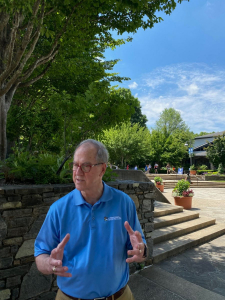
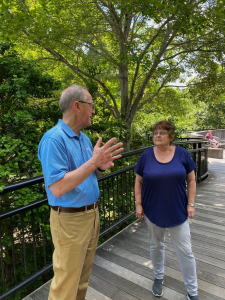
The plaque below also conveys his embrace of passion and commitment: Overlook in Honor of Sara Hunt Briggs, A Tribute from Her Husband in Celebration of 50 Years of Marriage. How fitting that Judy and I were there celebrating our 50th!
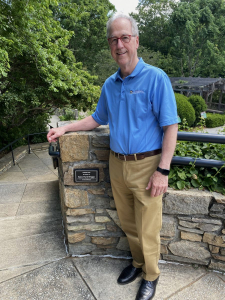
This just-under-four-minute video tells the tale of the Arboretum and evidences the interdependence on plants, people, place, and passion.
Special Features
Without a lot of narrative, I offer a photo collage of special features and this special place. The Quilt Garden and fountain.
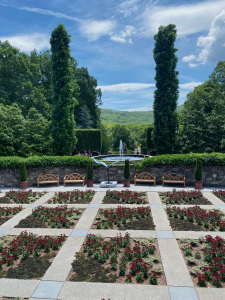
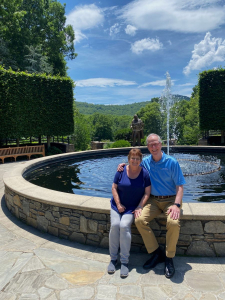
Working greenhouse with lenticular clouds in the background.
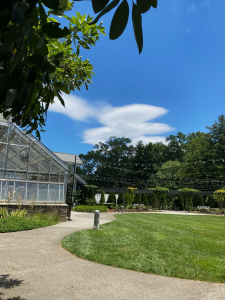
Stillness Meets Trajectory Sculpture of a great blue heron.
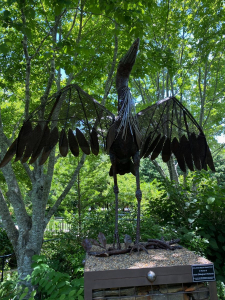
Bonsai Exhibition Garden with native southern Appalachian forest species: white pine and red maple.
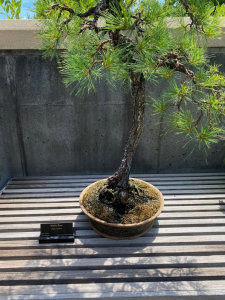
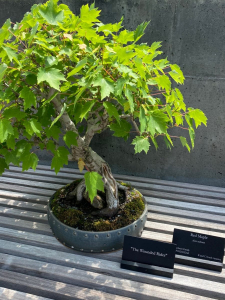
The exhibition offers far more than just these two representative examples.
Nature’s Subtleties: Lichens
Although not a subject of any intentional demonstration, lichen caught my eye, hidden as so much in Nature is in plain sight. Here on the bark of an American yellowwood.
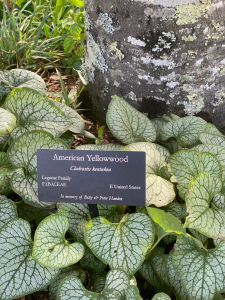
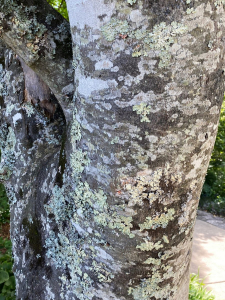
On an ornamental flowering cherry.
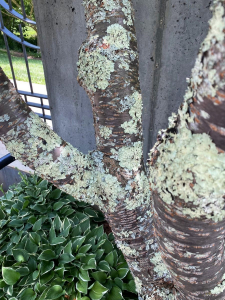
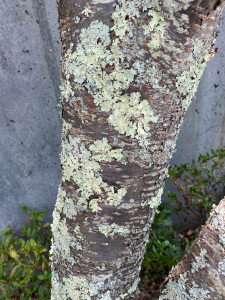
On a split rail fence bordering a woodchip-surfaced pathway.
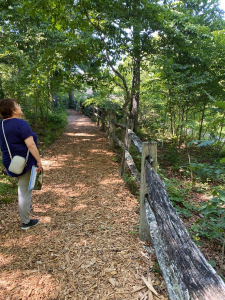
Note the creative employ of windthrow-uplifted roots as a fence segment, and lichens and moss on one of the fence rails.
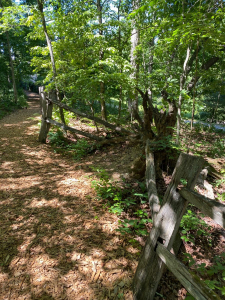
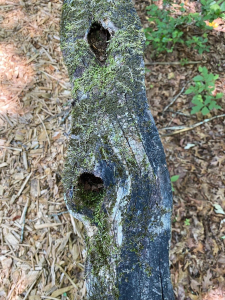
Deep in the Southern Appalachians
Allow me to circle back to the original Biltmore Estate. Olmsted was not impressed with the condition of the 125,000 acres (195 sq mi; 510 km2) and advised having a park surround the house, establishing farms along the river, and replanting the rest as a commercial timber forest, a plan to which Vanderbilt agreed. Gifford Pinchot and later Carl A. Schenck were hired to manage the forests, with Schenck establishing the first forestry education program in the U.S. in 1898, the Biltmore Forest School, on the Estate grounds. I photographed the plaque below on the Biltmore Estate.
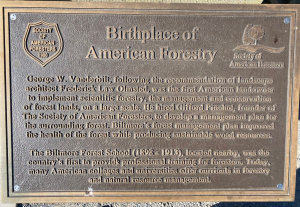
The birthplace of American forestry (known as The Cradle of Forestry) is in the center of the Pisgah National Forest, 24 miles from the Arboretum and 31 miles from the Biltmore House, all three locations within the vast original Estate. I remind you that the forests of 1890 looked nothing like the mature forest below left or the sweeping vista from George’s office (right).
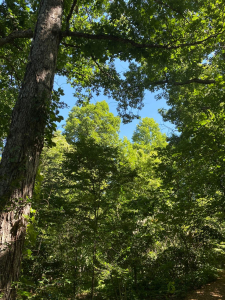

I could write for days…no, years…and never so succinctly capture my own feelings for these southern Appalachians than did John Muir on mountains in general:
- Oh, these vast, calm, measureless mountain days, inciting at once to work and rest! Days in whose light everything seems equally divine, opening a thousand windows to show us God. Nevermore, however weary, should one faint by the way who gains the blessings of one mountain day; whatever his fate, long life, short life, stormy or calm, he is rich forever.
This old forester, enriched by 71 years of Nature-oriented and inspired living, and a 50 year journey with the love of my life, loves mountains. Yet, I am in love with these ancient southern Appalachians. They lie deep within me. They sculpt my very being. I am rich forever.
Repeating Muir:
The mountains will kill care, save you from deadly apathy, set you free, and call forth every faculty into vigorous, enthusiastic action.
Thoughts and Reflections
I offer these observations:
- Going to the southern Appalachian Mountains is going home (modified from John Muir).
- A true Nature enthusiast enters wild places buoyed by deep and persistent passion.
- Embrace your own special-place Eden; carry it in your heart and soul!
Inhale and absorb Nature’s elixir. May Nature Inspire, Inform, and Reward you!
Note: All blog post images created & photographed by Stephen B. Jones unless otherwise noted. Please circulate images with photo credit: “©2022 Steve Jones, Great Blue Heron LLC. All Rights Reserved.”
Another Note: If you came to this post via a Facebook posting or by an another route, please sign up now (no cost… no obligation) to receive my Blog Post email alerts: http://eepurl.com/cKLJdL
And a Third: I am available for Nature-Inspired Speaking, Writing, and Consulting — contact me at steve.jones.0524@gmail.com
Reminder of my Personal and Professional Purpose, Passion, and Cause
If only more of us viewed our precious environment through the filters I employ. If only my mission and vision could be multiplied untold orders of magnitude:
Mission: Employ writing and speaking to educate, inspire, and enable readers and listeners to understand, appreciate, and enjoy Nature… and accept and practice Earth Stewardship.
Vision:
- People of all ages will pay greater attention to and engage more regularly with Nature… and will accept and practice informed and responsible Earth Stewardship.
- They will see their relationship to our natural world with new eyes… and will understand more clearly their Earth home.
Tagline/Motto: Steve (Great Blue Heron) encourages and seeks a better tomorrow through Nature-Inspired Living!
Steve’s Three Books
I wrote my books Nature Based Leadership (2016), Nature-Inspired Learning and Leading (2017), and Weaned Seals and Snowy Summits: Stories of Passion for Place and Everyday Nature (2019; co-authored with Dr. Jennifer Wilhoit) to encourage all citizens to recognize and appreciate that every lesson for living, learning, serving, and leading is either written indelibly in or is powerfully inspired by Nature.
I began writing books and Posts for several reasons:
- I love hiking and exploring in Nature
- I see images I want to (and do) capture with my trusty iPhone camera
- I enjoy explaining those images — an educator at heart
- I don’t play golf!
- I actually do love writing — it’s the hobby I never needed when my career consumed me
- Judy suggested my writing is in large measure my legacy to our two kids, our five grand kids, and all the unborn generations beyond
- And finally, perhaps my books and Blogs could reach beyond family and touch a few other lives… sow some seeds for the future


All three of my books (Nature Based Leadership; Nature-Inspired Learning and Leading; Weaned Seals and Snowy Summits) present compilations of personal experiences expressing my (and co-author Dr. Wilhoit for Weaned Seals and Snowy Summits) deep passion for Nature. All three books offer observations and reflections on my relationship to the natural world… and the broader implications for society. Order any and all from your local indie bookstore, or find them on IndieBound or other online sources such as Amazon and LifeRich.

